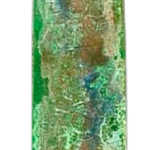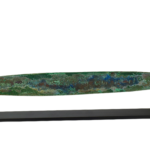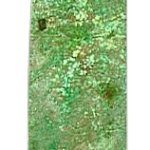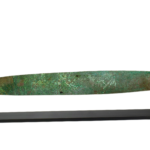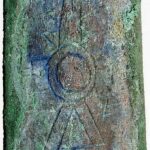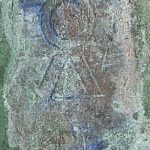Paracas Copper Short Spear
Intricate Details and Artistic Narrative of this
Paracas Short Spear
Paracas Copper Short Spear. This extraordinary bi-point artifact is uniquely shaped and bears iconographic importance. It is produced from native copper, and the blade boasts mythical beings. Six geometrically stylized double-headed falcons grace each side of the blade.
This piece must have held great symbolic value and was made for someone of high importance. Its luster would have been bright and shimmered while being held from its cloth-wrapped center. Today, trapped from its isolated arid environment, a gorgeous green and blue-colored verdigris patina has been created and encases the artifact.
The Double-Headed Falcon is a significant motif in the Paracas civilization and is frequently found in their textiles, ceramics, and other artifacts. This symbol offers a deep insight into the society’s values and beliefs.
In Paracas culture, the double-headed falcon is seen as a symbol of power and authority. Birds of prey, such as falcons, are associated with strength, vision, and control, qualities likely revered by the Paracas elite. This motif may also have held spiritual and cosmological significance, reflecting the Paracas people’s rich spiritual life. The dual heads could symbolize various dualities within their belief system, such as life and death, the earthly and the celestial, or the physical and spiritual realms.
The role of the double-headed falcon in funerary practices further underscores its importance. Paracas textiles, which frequently feature this motif, were commonly used to wrap mummies, suggesting that the falcon might have been seen as a protective figure, guiding and safeguarding the deceased in the afterlife.
Artistically, the double-headed falcon is prominently featured in Paracas textiles, renowned for their complexity and vibrant colors. These textiles demonstrate Paracas artisans’ high level of skill and the importance of this motif in their art. The falcon also appears on Paracas ceramics, which are used in both daily life and ceremonial contexts, indicating its widespread cultural significance. Its iconography, characterized by its symmetrical form and geometric patterns, is striking and distinctive.
The significance of the double-headed falcon was revealed through archaeological excavations, particularly those conducted by Peruvian archaeologist Julio C. Tello in the early 20th century. These excavations unearthed numerous textiles and artifacts adorned with this symbol, offering valuable insights into the Paracas civilization. While scholars have debated the exact meaning of the double-headed falcon, its recurrent appearance suggests it was a potent symbol. Some theories propose it represents shamanistic visions or experiences, while others see it as an emblem of political power.
Similar motifs are found in other ancient American cultures, indicating possible cultural exchanges or common symbolic themes. For instance, the double-headed bird motif is also present in the art of the Nazca, who succeeded the Paracas culture in the region.
In conclusion, the Paracas Double-Headed Falcon is a powerful and multifaceted symbol that played a crucial role in the Paracas civilization’s spiritual, artistic, and political life. Its presence in various art forms and its association with significant cultural practices highlight its importance and the sophisticated nature of Paracas society.
Note:
A non-invasive test using energy-dispersive X-ray fluorescence has been performed by Geotechnical Services, Inc., to analyze its composition accurately. Six locations were targeted to avoid cross-contamination. 99.849 Cu; 0.131 Fe; 0.018 Ni. The reading shown is from one spot, which yielded the highest trace elements. The conclusion is this is Native copper. Our research led us to believe this implement was sourced from the “Mina Perdida” Lost Mines in northern Peru. Native copper was used in the earliest pieces. Techniques were developed later to produce alloys through cultural evolution. From the manufacturing viewpoint, the artisan had superior skill and talent to create this desired shape and thickness. Cold hammering with some heat applied and not cast like commercialized “Tumis” (half-moon blades with handles) used in later cultures.
Also, QC Metallurgical, Inc. performed a semi-quantitative EDS analysis on the patina to determine its elemental composition. The surface material was copper chloride, naturally formed due to the arid climate and the close proximity to the ocean environment. Elemental composition: O K 19.15; AI K .58; Si K 1.07; Cl K 15.22; Fe K .70; Cu K 63.29.
All reports are available upon request.
This impressive blade stands out due to its unique shape, size, composition, and iconography.
Paracas/ Proto-Nazca culture, Peru c. 800 BC – 100 BC.
Length is 19.25”/48.89 cm.
Near choice condition.
Provenance: Ex-Oswalt collection, Scottsdale, AZ. Acquired 1970s
Price – $12,500. – Domestic Delivery Included
- Explore comparable antiquities on display at renowned museums to appreciate the history and artistry behind our collection. Museum Collection Portal
- Click here to see our next selected item.
- Are you searching for a particular piece and not finding it? Let us help.
- Regional Division of Pre-Columbian Americas’ Major Archaeological Cultural Phases.
- Visit us here at the Native American Art Magazine

